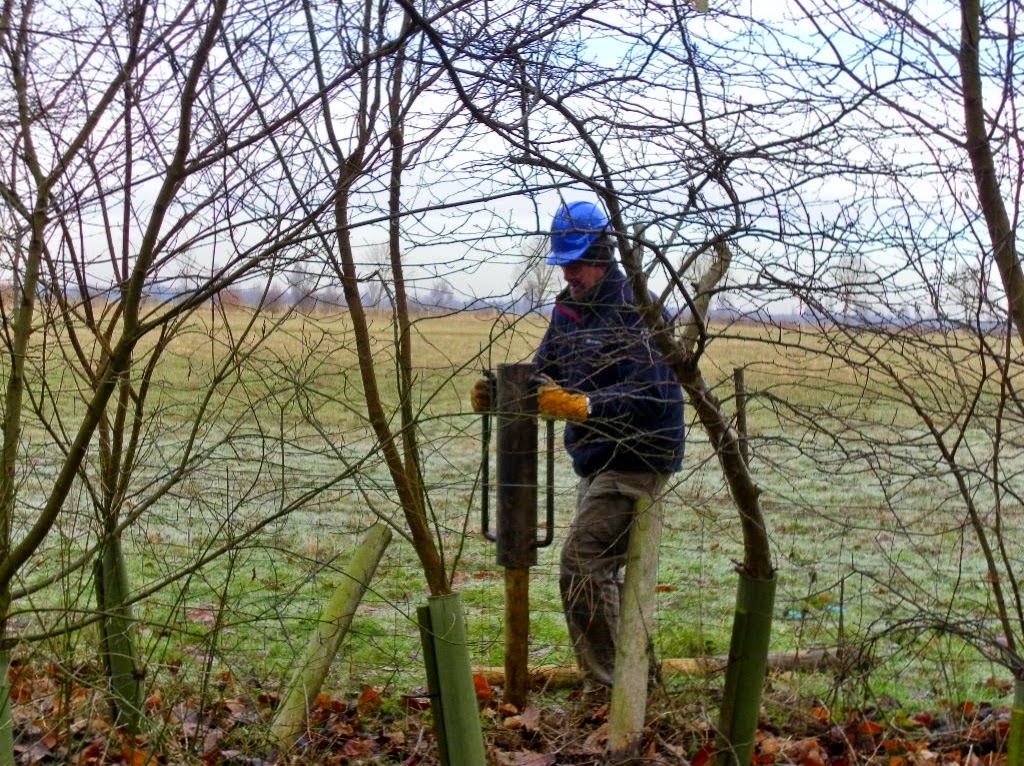That which
had hitherto merely been suspected, is now official: Green-Gymmers generally
may seem mad; ‘C’, however, is definitely a nutter.
There is a
sticker on my jacket to prove it:
I knew there
must have been something seriously wrong with my head when I found myself setting off
last Saturday morning, while the snow was tipping out of the sky over my home
village, to go on a Nut Hunt. No wonder
no-one else from Green Gym accepted the invitation from the Anne Carpmael
Trust, for whom we have often done jobs.
The
nuts referred to were
hazelnuts, and the reason for seeking discarded shells beneath the hazelnut
trees on a site is to find proof of the presence of dormice.
The evidence lies in the precise form of the
empty wrappings, for plenty of creatures eat hazelnuts.
I myself have a fondness for
Nutella, which I first encountered in
the days when it could only be obtained on the continent.
No trip to Germany was complete without stopping
off at a supermarket to buy one of the very distinctive jars to take home –
invariably to the amazement of my hosts, who regarded a taste for Nutella as
being one of those childhood fancies, which should be outgrown as an adult.
In the
animal kingdom, the key question re hazelnuts is: How do you open yours?
Dormice have a distinctive and unique
technique.
Woodmice and voles crudely gnaw
through the shells; squirrels use brute force to crack them open.
Only dormice have learned that the trick to slicing
open a nut elegantly is to hold one in their little paws, make an incision with
their bottom teeth, and then instead of moving their jaws, rotate the nut, so
that their lower jaw acts like a can-opener.
The result is that a
dormouse nut
will feature an exceptionally smooth edge, with no little teeth-marks on the
outside.
It is, of course, easier to
look for dormouse nuts in the autumn, when the casings are still green, and not
covered with brown leaves – or snow.
Tuesday’s
task, by comparison, seemed positively sane: pruning willow sculptures.
Willow-coppicing we had done the week before,
and may well be doing the next time we visit an
Anne Carpmael Trust site, in a fortnight’s
time. This week, however, the objective
was to shape willow into artistic form.
As usual on
this task, the session began with guessing what shape each individual sculpture
was meant to be.
The clue is that they
are all on nautical themes, to commemorate the
Battle of Trafalgar.
Even ‘
HMS Neptune’ (quarter-size) was not so
easy to recognize this morning:
The
structure popularly known as ‘the Willow Tunnel’ is meant, I think, to
represent a telescope:
There were
originally four sculptures on site, but we were concerned only with the first
two. Of the remainder, one seems to have
gone the way of the world. The other,
which had clearly already received some attention recently, might be intended
to suggest a pile of cannon-balls:
Where the
sculptures were thin, a certain amount of weaving was required:
“More
lopping than weaving”, however, was what most of the task called for. Also sawing, where branches had grown
thicker.
This generated a large number
of rods, all of which could go to the Earth Trust’s Education Department for
use in teaching children about basket- and hurdle-weaving. Said bundles needed to be tied up …
then carried
over to the transport, and loaded:
Meanwhile –
for benefit of those who just can’t stand willow-sculpture maintenance – there had
been some fence-posts to be replaced:
Not so easy
a task when the ground was frozen first thing.
What the other snag was with the task, I could not quite fathom. When I trogged along to see how the chaps
were getting on, and found them saying in mournful (also puzzled) tones, “Oh,
what have we done?” I thought maybe I should just leave them to it:
Whatever the
problem was, clearly it had been solved by session end, as they returned to the
sculpture park well content with their morning’s work.
As for the labours of the rest of the crew, the outline of a Nelson-era battleship could now be clearly discerned:
The willow
tunnel was looking much more inviting for young visitors to come and play:
With a
little imagination, one could interpret the shape as a telescope:
 |
| “It’s not
quite Hubble” |
My lying
down to take that last shot (that’s what waterproofs are for!) could be interpreted
either as dedication to my craft, or as further evidence of nuttiness.
And the news
from Saturday’s Nut Hunt was that, by sheer persistence, members of the Oxfordshire
Mammal Group did manage to find the evidence they were looking for. Congratulations all round!























